Born in 1987 in Palma de Mallorca, Spain, residing and working in Toulouse, France, Alejandro Javaloyas is a post-minimal abstract painter exploring the sculptural qualities of the painterly surface. Instead of working on canvas, Javaloyas’ designated surface is veneered plywood, which he bends, cuts, drills, polishes, and paints to create his typical convex panels. On the occasion of his residency at La BIBI—where the artist has developed a new series of works—we are pleased to have a chat with the Spanish-French artist, discussing his personal journey as an artist, the intersection of sculpture and painting, spheres, his latest series of works, and much more.
Julien Delagrange: Hi Alejandro, I trust you have been doing great at the La BIBI Residency. Could you describe your initial impressions of La BIBI—the views of Palma Bay, the Serra de Tramuntana, or the environment they provide to enhance your creativity and productivity?
Alejandro Javaloyas: Hi Julien, thanks for asking! The La BIBI Residency has truly been an incredible space for creation. It’s housed in a beautifully renovated old warehouse in Establiments, a tiny village just a short drive from Palma, the island’s capital city. The location is perfect—tucked away in the countryside, offering breathtaking views of the surrounding fields and the Serra de Tramuntana mountains. The idyllic setting is just inspiring; it’s a painter’s dream.
The studio benefits immensely from its design, with massive windows and a glass roof that let in abundant natural light, also thanks to the lovely Mediterranean climate here. I can enjoy both the sunrise and sunset right from my workspace, with the sound of birds filling the air all day. It’s quite a contrast to my usual routine back in Toulouse—here, I don’t have the distractions of a day job, a dog, a boyfriend, social temptations, or household duties. This semi-isolation for a whole month has supercharged my productivity and creativity. I’ve had the space, light, and time to get myself permission to get more playful with my work, think outside the box, and create pieces that wouldn’t have been possible in my own studio.
JD: Does this setting impact your process, or has it inspired you to include new elements in your work?
AJ: Absolutely, Julien! The setting at La BIBI has influenced my process more profoundly than I initially expected. Being someone who likes to plan meticulously, I arrived with a plethora of sketches and studies from my studio in Toulouse, aiming to hit the ground running. My plan was to efficiently create a new body of work that lived up to the gallery’s expectations without squandering any time, simply because I know that time flies and one month is a rather short residency. However, something unexpected happened right in my first couple of days here. The vast open skies visible from the east-facing windows took me by surprise. The sunrises here are just magnificent, casting incredible gradients across the sky.
I found myself captivated by these subtle shifts in color and light, which have deeply influenced the palette of my new pieces. As a result, I’ve moved away from the darker block colors that characterized my latest work in Toulouse. The new pieces reveal desaturated light and nuanced gradients that seem to borrow directly from the surrounding landscape. This shift towards a brighter and more contextually integrated body of work seems natural, given the brilliant light in Mallorca.
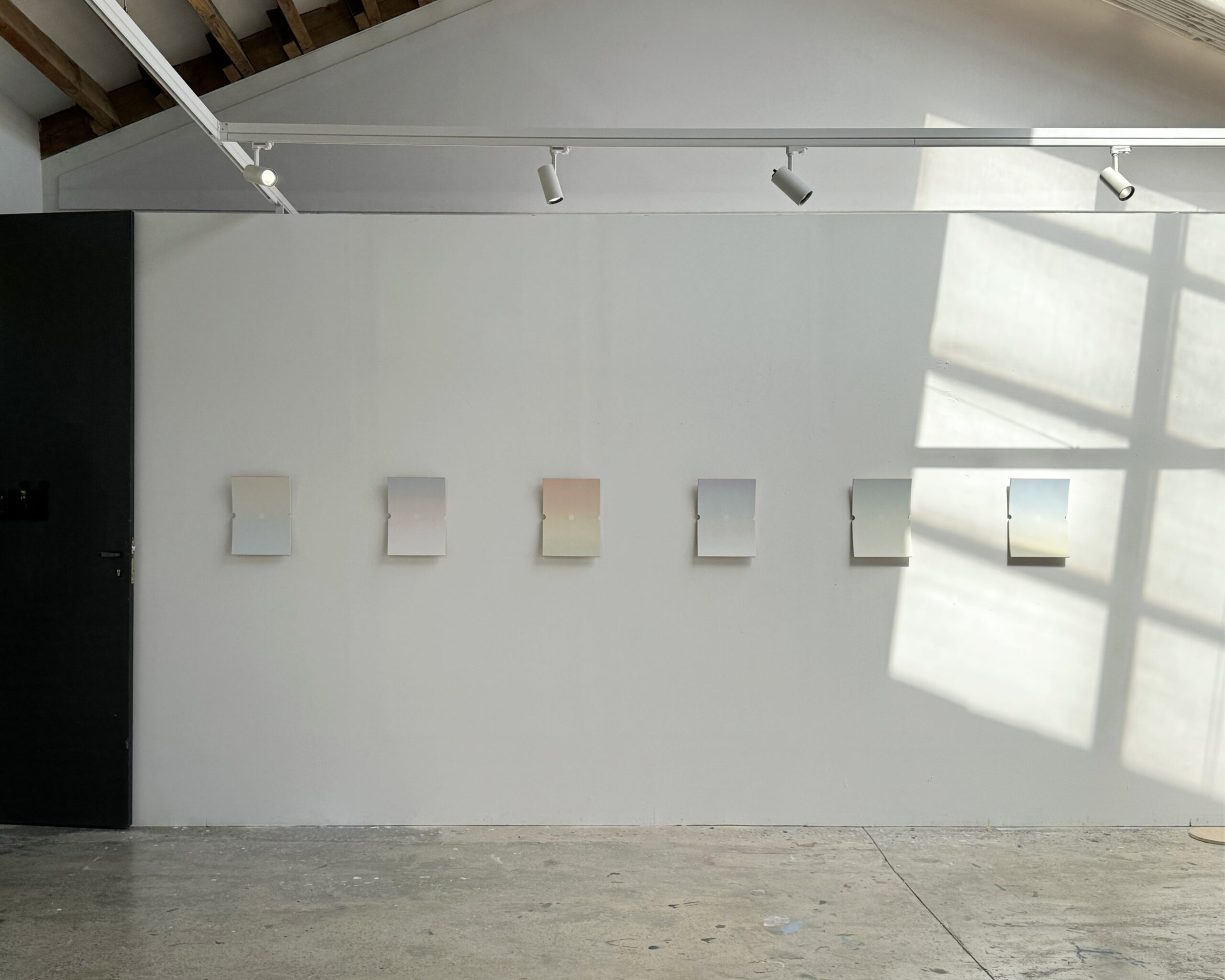
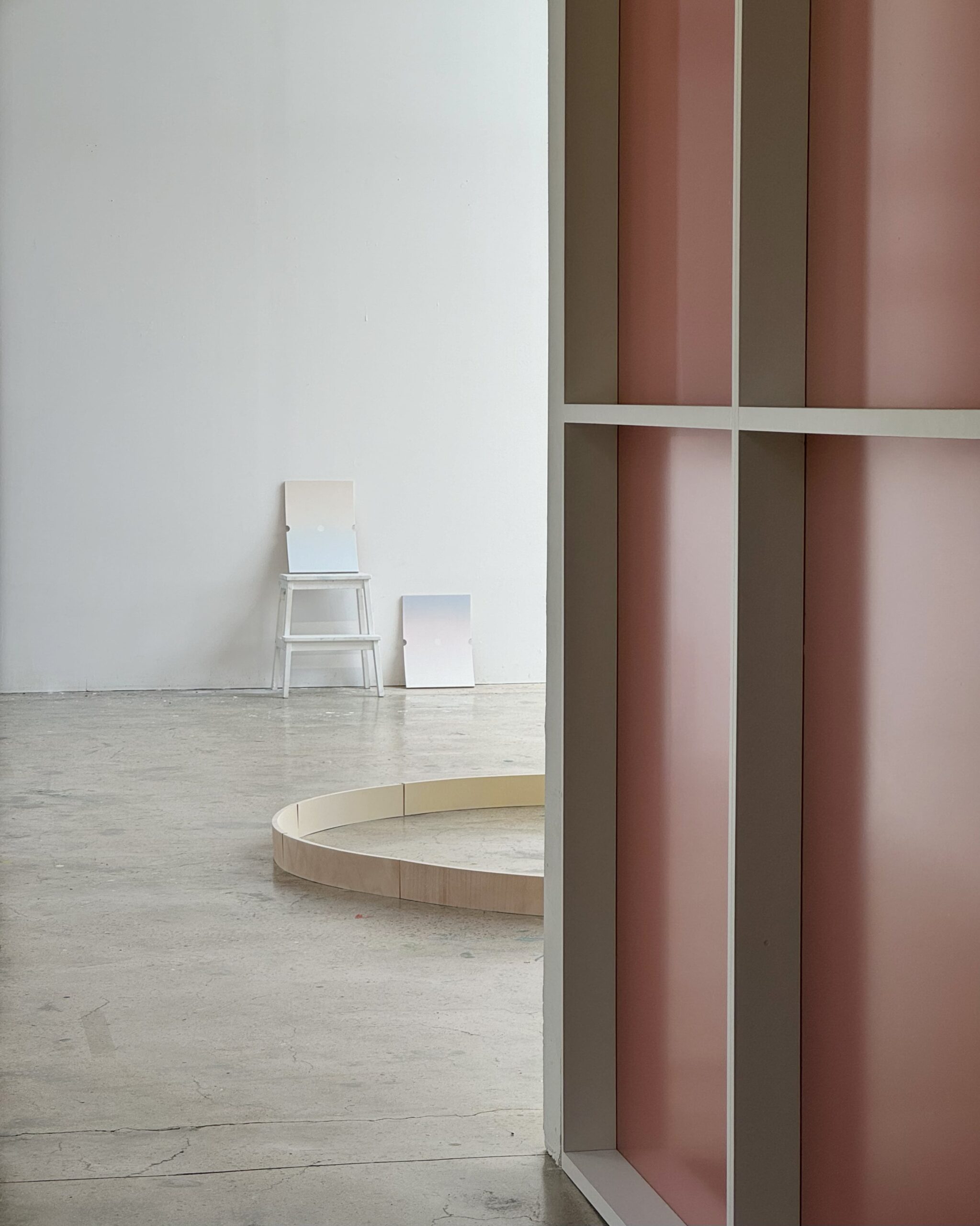
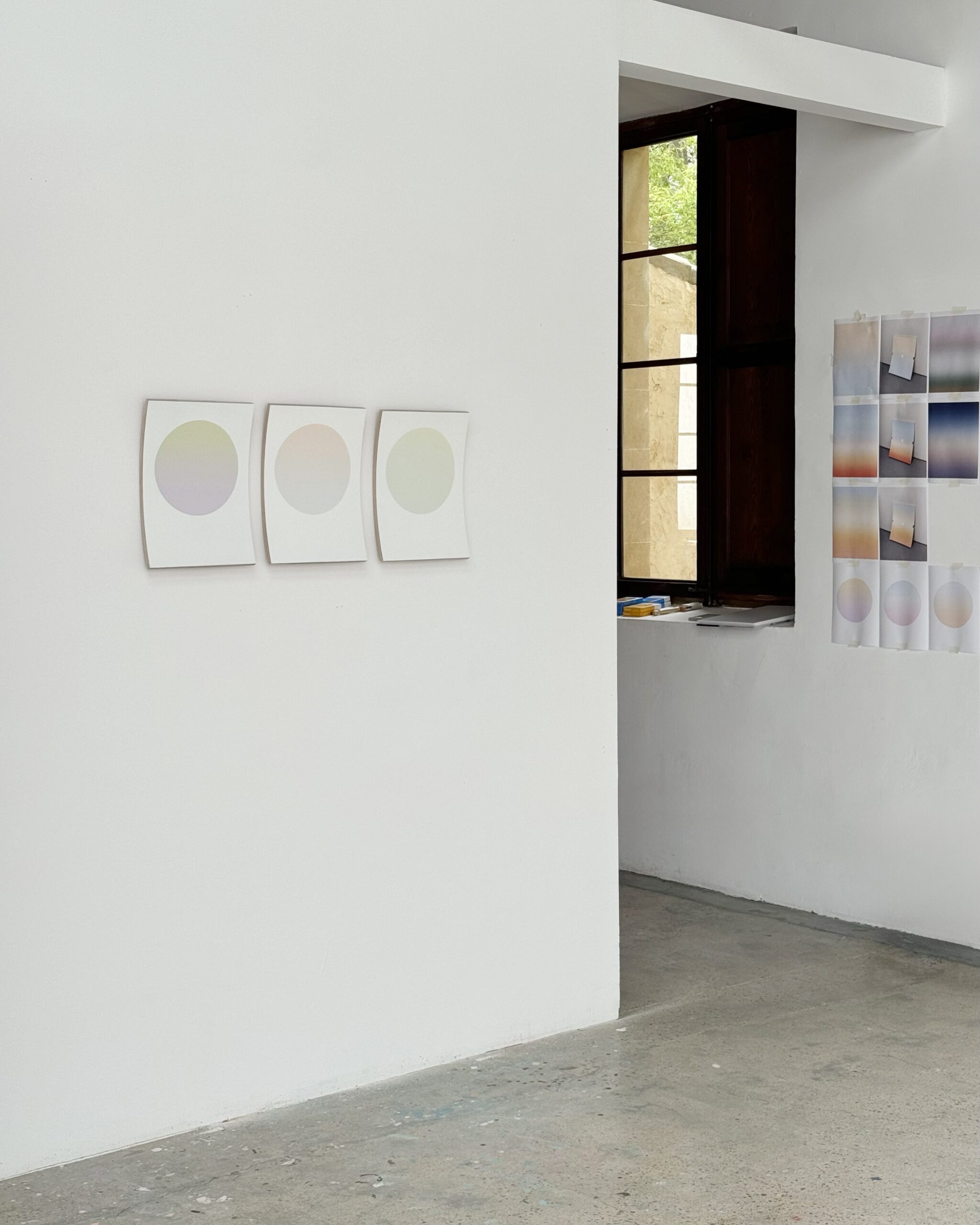
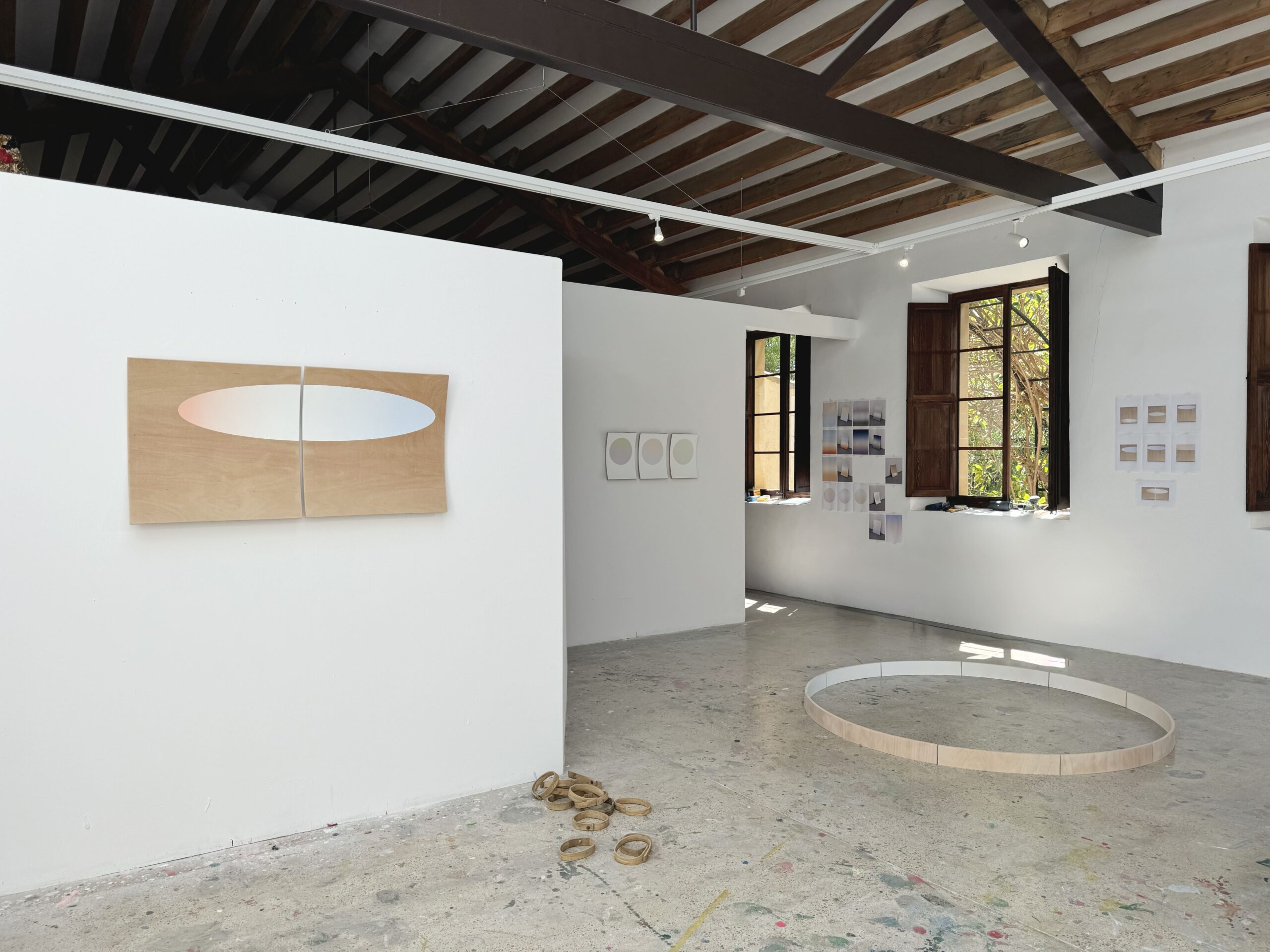



JD: Some of our readers might remember you from our group exhibition with the CAI Gallery program titled Catharsis. Today, we have the opportunity to expand on your current practice and the latest series of works marked by bent plywood panels and minimalism. However, before we dive into what keeps you busy today, I would like to ask you about your background first. You have a background in filmmaking but, in the end, became a painter. Could you please tell us a bit more about your first steps towards artistry? Where did things start to shift and, in the end, start to click, resulting in your current visual language?
AJ: I’ve always been deeply immersed in many creative activities. My journey into art began at a very young age; I was constantly drawing and painting, leading my mother to enroll me in a private art school when I was just six. This education lasted until the age of eighteen. It was intense and highly academic, covering everything from life drawing—like still lifes, architectural elements, and figure drawing—to mastering various mediums such as graphite, charcoal, soft pastel, watercolor, and oil. We also dived deeply into color theory, composition, and perspective, and I spent many hours copying masterpieces from the Baroque and Impressionist periods.
Despite this rigorous focus on figurative art, my true passion for abstraction was ignited during my teenage years. I remember visiting the Museu Fundación Juan March in Palma, which features a sublime Spanish After-Civil-War painting collection, and experiencing a profound emotional and spiritual connection to the works of Spanish Informalist painters like Fernando Zóbel, Antoni Tàpies, Luis Feito, Eduardo Chillida, and Antonio Saura, among others. This exposure was transformative, pivoting my artistic practice towards abstraction. As I delved deeper into Abstract Expressionism, Color Field painting, Minimalism, and Post-Minimalism, I found my true artistic lane.
When it came time for higher education, I chose to study filmmaking at the ESCAC, the Barcelona Film School, drawn by my love for films and perhaps a naive belief that it might be a more viable career path than painting. I thoroughly enjoyed my studies and the creative process involved in filmmaking, especially films that eschew traditional dramatic structures and push boundaries, much like how painting got rid of representation and interpretation to move from figuration to abstraction. Filmmakers like Michelangelo Antonioni, Alain Resnais, Chris Marker, David Lynch, Béla Tarr, Roy Andersson, and Michael Haneké helped me appreciate artworks, both films and paintings, that do work based on their atmosphericity, an uncanny, eerie mood that’s intangible and not obvious that activates the piece at a very spiritual level. Although I decided not to pursue a career in filmmaking, my film school journey clearly informed my visual taste and judgment, as well as the way I approach making images and what I expect from them.
JD: Let’s discuss the veneered plywood panels, which are at the very center of your practice. Why did you abandon the canvas and start working on a panel?
AJ: That’s a great question. The shift from canvas to bent veneered plywood was significant for me. I wanted to break free from the traditional constraints of the classical flat canvas that hangs against a wall, which began to feel too limiting for the spatial and object-like qualities I wanted to explore in my work. I was inspired by modern masters like Lucio Fontana, Ellsworth Kelly, and Ron Gorchov, who each approached the problem of the canvas’s limitations in different innovative ways. The canvas is one out of a thousand conventions that exist in the art world and that we have inherited. As Howard S. Becker says, these conventions are social contracts, collective agreements, that indeed can facilitate artistic production, but contracts and conventions can also be challenged, questioned, and eventually changed.
After many months of exploration, I began to feel satisfied with some of the shapes I created, and mildly bending plywood soon became a central aspect of my recent work. The pieces are not flat, which makes them more versatile and offers plenty of possibilities to activate the exhibition space. By exposing the plywood layers on the sides and allowing the material’s qualities to come forward, the works blur the lines between furniture design, product design, and painting. These pieces can be hung, moved, or even placed on the floor or a bookshelf, enhancing their object dimension. Moreover, bending a rigid material like plywood challenged and altered its expected physical behavior, making it act more like cardboard or thick paper. This transformation has opened up new possibilities for me, and I’m really enjoying exploring this medium further in my current practice.
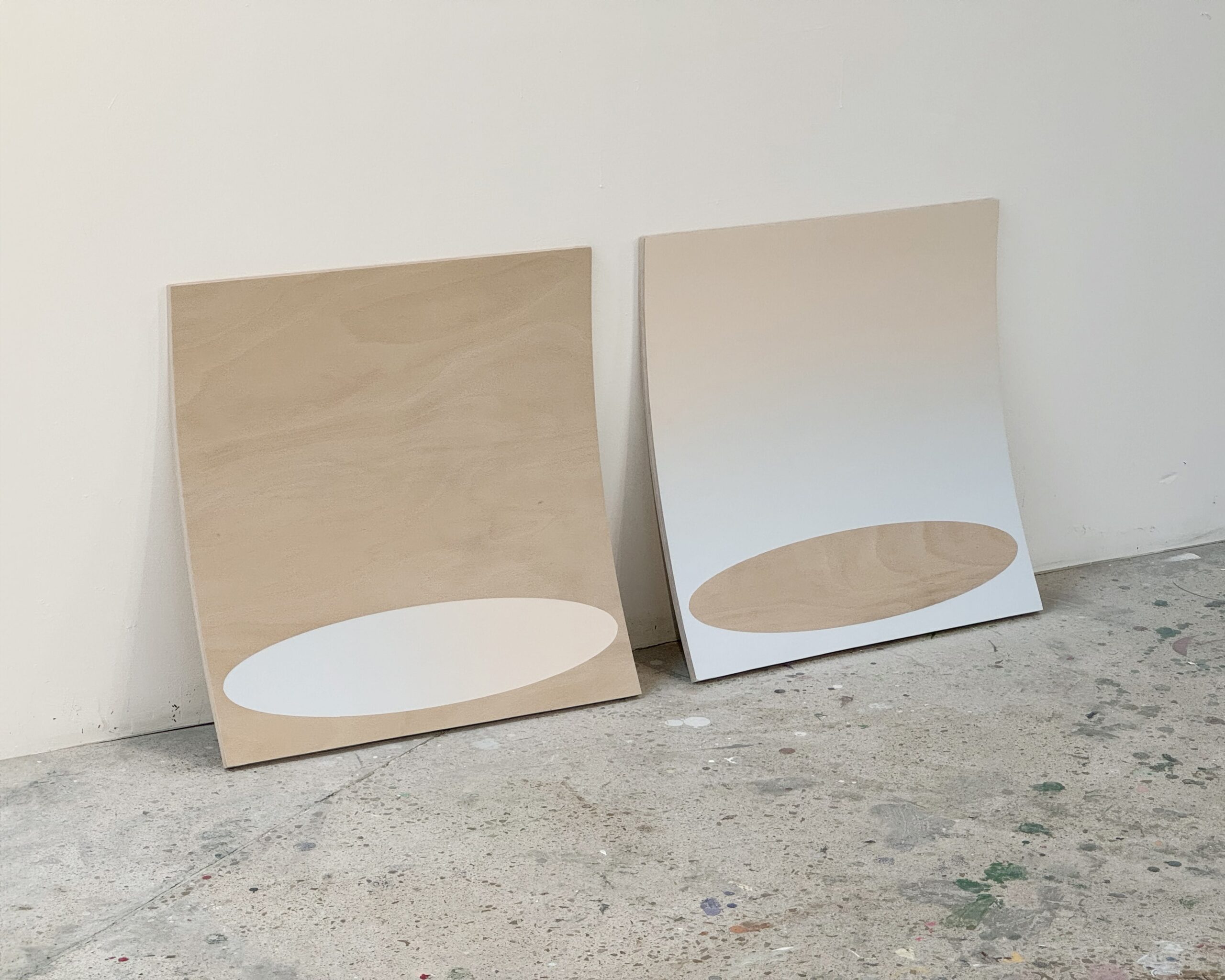

JD: In a sense, your surface is also the medium, and it seems like you are taking this notion to the next step during your residency at La BIBI, in which the natural structure of veneered plywood remains visible in works such as Mécanismes d’Abstraction d’une Ellipse (2024) or Poème Chromatique en Isolement Sémiotique (2024).
AJ: Absolutely, Julien. My journey towards minimalism is indeed a conscious endeavor to get rid of everything unnecessary, to strip down my practice to its essentials. Like John McLean once said, “I think with my own work that the simpler I can make it, in a strange way, the more profound I feel it is.” The only thing that one can’t get rid of is the actual canvas, the support, which needs to be there for the painting to exist. That’s when I started to reconsider the very foundation of painting—the surface itself—not just as a backdrop but as an active medium that I had to explore and, in itself, play with.
In traditional painting, the canvas is an indispensable element, a silent participant who holds the work but doesn’t usually interact with it. I wanted to challenge this idea by not only using the surface as the medium but also by altering its form. By bending the plywood into an arch—a shape that suggests a circle if completed—I am able to echo the recurring painterly elements in my work: the circle, the circumference, the dot, the sphere, the hole, the ellipse. This way, the canvas and its shape are treated equally from a composition and conceptual standpoint.
During my residency at La BIBI, this exploration has deepened. Previously, I mainly exposed the natural plywood along the edges of my pieces, playing with its textural contrast, like Donald Judd’s chairs. Here, I’ve pushed this further by letting the veneered plywood’s natural structure and color serve as both a background and a foreground in pieces like Mécanismes d’Abstraction d’une Ellipse and Poème Chromatique en Isolement Sémiotique. This approach allows the material itself to interact more directly with the painted elements, exploring the tension between form and shape, figure and ground, positive and negative space, object and wall.
JD: Your paintings are both painterly and sculptural, as these wall objects are shaped as an arch, a fragment of an incomplete circle. Could you elaborate on the formal and symbolic purpose of this key motif in your practice?
AJ: As mentioned before, I actively reviewed my practice to eliminate any unwarranted formal elements and simplify my painting vocabulary. I quickly realized that the circle, sphere, and dot were recurring leitmotifs I was willing to preserve. I find these shapes fascinating geometrically. Unlike the triangle, the square, and other more complex polygons, the circle is the only 2D geometrical shape formed by a single line. It results from taking a segment (radius), fixing one of its extremes (center), and spinning it to define a set of points, all equidistant from the center. In a way, it conveys movement in a medium of still images since motion is required to generate this simple, perfect, yet complex and beautiful shape. Equally, it evokes circularity and rebirth and has a holy edge.
Secondly, I find it fascinating that depending on the scale of the canvas and the wall, the same shape can be read as different things. It can be a circumference, a circle, a hole, or a dot. It can be positive or negative space; therefore, add or subtract volume. Even the ellipse can be seen as a projection of a circle onto a plane tilted relative to the circle’s axis. Plato would argue it is merely a shadow cast on a cave’s wall. Kant would distinguish between phenomena, or how things appear to us, vs noumena, or how things are in themselves. So lastly, I’m also interested in delving into the philosophical, aesthetic, and art historical significances of the sphere as a geometric element, a symbol, and a habitable space, inviting viewers to ponder its broader existential and sociological implications.
JD: Your work consists of various other recurring motifs, such as the gradient. With what intent do you approach these visual strategies, and how do they contribute to your ongoing exploration of matter, form, shape, and the symbolical potential of everything above?
AJ: Absolutely, Julien. My background in filmmaking significantly informs the visual strategies I employ in my paintings, particularly in how I approach gradients. In classical cinema, the narrative typically unfolds in three acts involving a protagonist overcoming obstacles to achieve a goal. This dynamic of conflict and resolution is what draws audiences into the story. In film, the illusion of motion is created by a series of frames shown in rapid succession, 24 per second. Many people think film is about depicting movement, but in my opinion, it’s fundamentally about depicting transformation—the evolution of characters and their circumstances.
This concept of transformation is something I parallel in my visual art through the use of gradients. Gradients in painting play a similar role. They are not just transitions from one hue to another; they represent a journey between states, embodying the concept and, more importantly, including the time axis into the equation. By using gradients, I can suggest movement and transformation within a static medium, adding a temporal dimension to the spatial and material ones already present in my work.
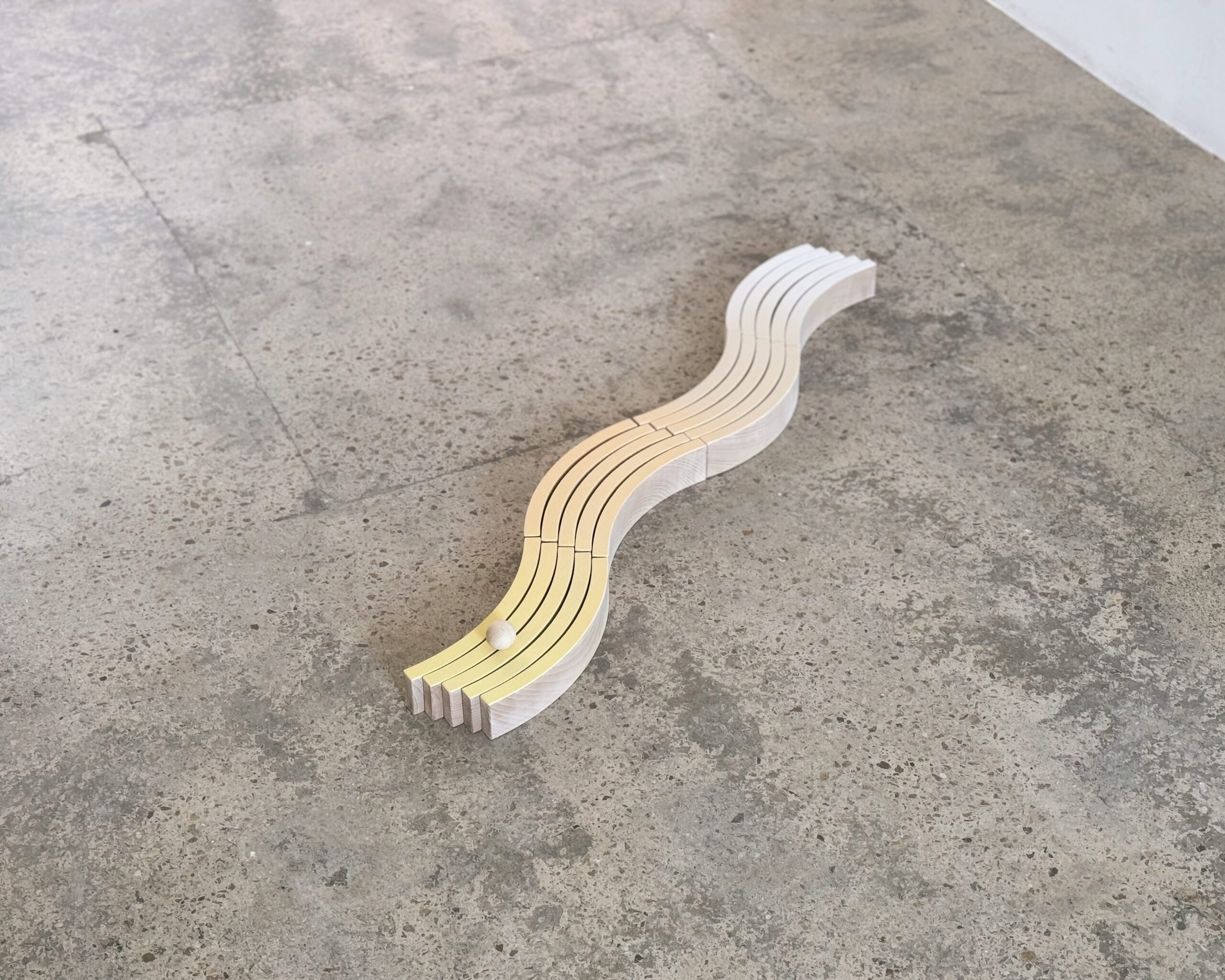
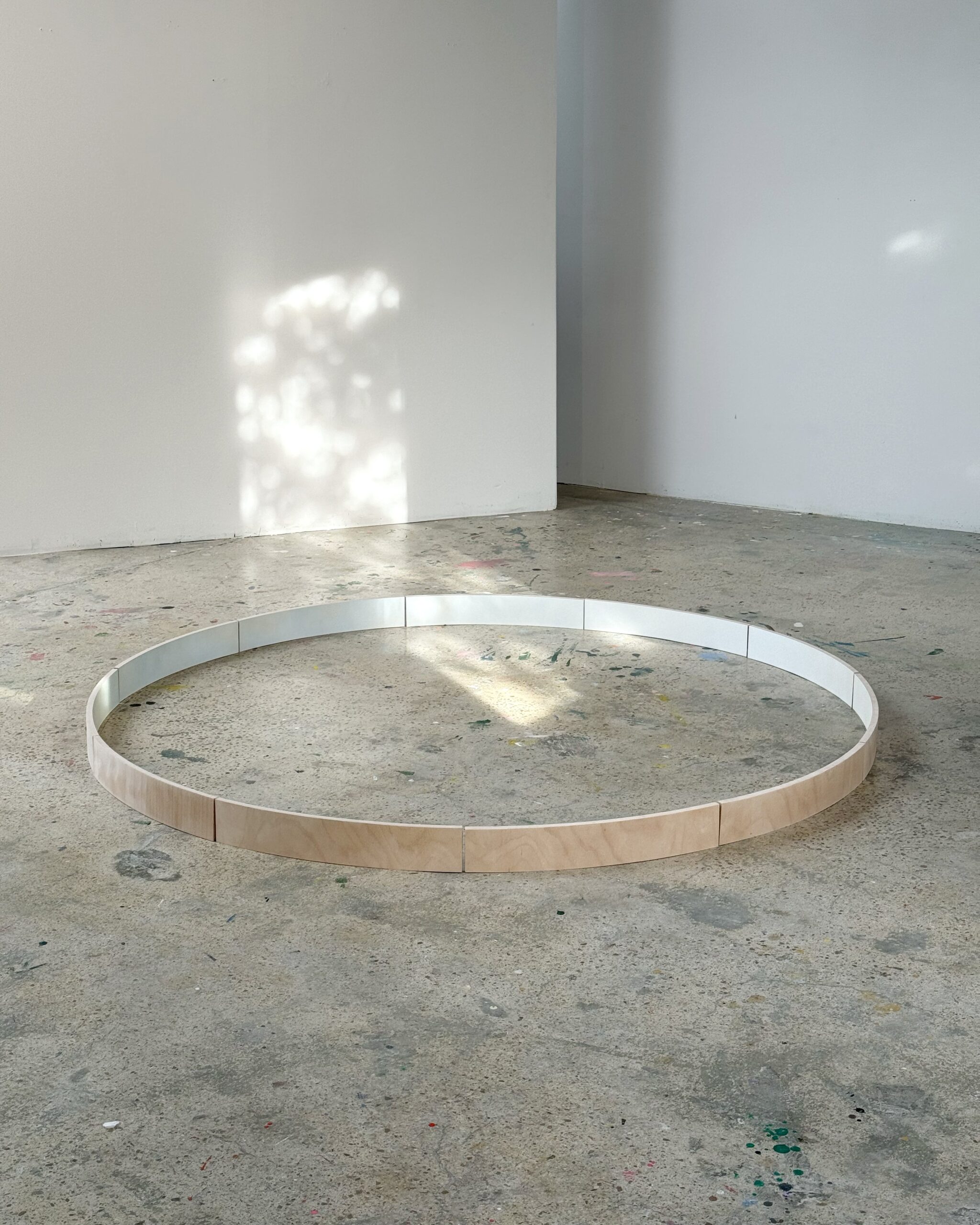
JD: The aforementioned incomplete circle has become a complete circle in your latest sculpture, Panorama d’une Mythologie Post Post-Minimaliste (2024), which was also created during your residency. It is accompanied by the curved line of We Must Journey On Until We Find the Road of Yellow Brick Again (2024). Have the wall sculptures become floor paintings?
AJ: Indeed. The transition from wall sculptures to what might be considered floor paintings represents a significant evolution in my practice, largely facilitated by the unique circumstances of the residency. The spacious studio and the uninterrupted time here have allowed me to venture beyond the usual constraints of my everyday environment and responsibilities, as I was saying earlier. The works you mentioned, Panorama d’une Mythologie Post Post-Minimaliste and We Must Journey On Until We Find the Road of Yellow Brick Again, embody this new direction.
These pieces maintain visual and material consistency with my previous wall-mounted works—they utilize bent plywood, and only one surface is painted, preserving the chromatic and gradient themes that define my oeuvre. However, by placing these works on the floor, I am expanding the spatial interaction and further exploring the sculptural possibilities. This shift also introduces a more playful and child-like quality into the works, which somehow resemble wooden building blocks for kids, a positive development. It feels like a natural progression, pushing the boundaries of my practice into new, previously unexplored dimensions.
JD: Do you have a personal favorite of all the works you have created at La BIBI?
AJ: Yes, if I had to choose a favorite from my time at La BIBI, it would likely be Panorama d’une Mythologie Post Post-Minimaliste (2024). This piece particularly stands out not only for its aesthetic qualities but also for its engagement with the viewer and the space it inhabits. The installation comprises eleven bent plywood blocks, each measuring 60×10 cm, arranged on the floor in a circular formation. The natural wood is visible along the edges and outer sides, while the interfacing surfaces feature a gentle color gradient transitioning from white through pale blush and yellow to blue. The gradient is so subtle that it requires the viewer to move around the circle to fully appreciate the shifting hues, mimicking the gradual color changes of the sky at dawn.
What makes this piece particularly special to me is its interactive nature. It becomes fully ‘activated’ only as viewers walk around it, engaging with it in a complete 360º experience. This engagement with the viewer and their movement through the exhibition space has been a revelatory aspect of my residency, opening up new avenues in my work. I find this interactive element, the requirement for viewer participation to complete the experience, particularly compelling and something I am eager to explore further in future works.
JD: To conclude, do you have any other projects in the future that you would like to share with us?
AJ: Absolutely, Julien. Looking ahead, I’m thrilled about the various opportunities and projects lined up. I’m currently being featured in a group exhibition at &Gallery in Edinburgh, which has been a fantastic experience. Additionally, I’m preparing for upcoming group shows in London and Mallorca. Each of these exhibitions offers a unique platform to showcase different facets of my work. Moreover, I will likely participate in an international art fair soon, which I’m very excited about. Of course, I warmly invite everyone to visit La BIBI Residency to see all these new pieces in person. It’s one thing to discuss art and quite another to experience it firsthand. I’m looking forward to sharing these latest developments with both new and familiar faces and to the continued dialogue that these works might inspire.
JD: Thank you very much, Alejandro, for your time and your latest series of work.
AJ: Thanks, Julien, for the engaging conversation and thoughtful questions. I appreciate your interest in my work and the opportunity to share it with your audience.
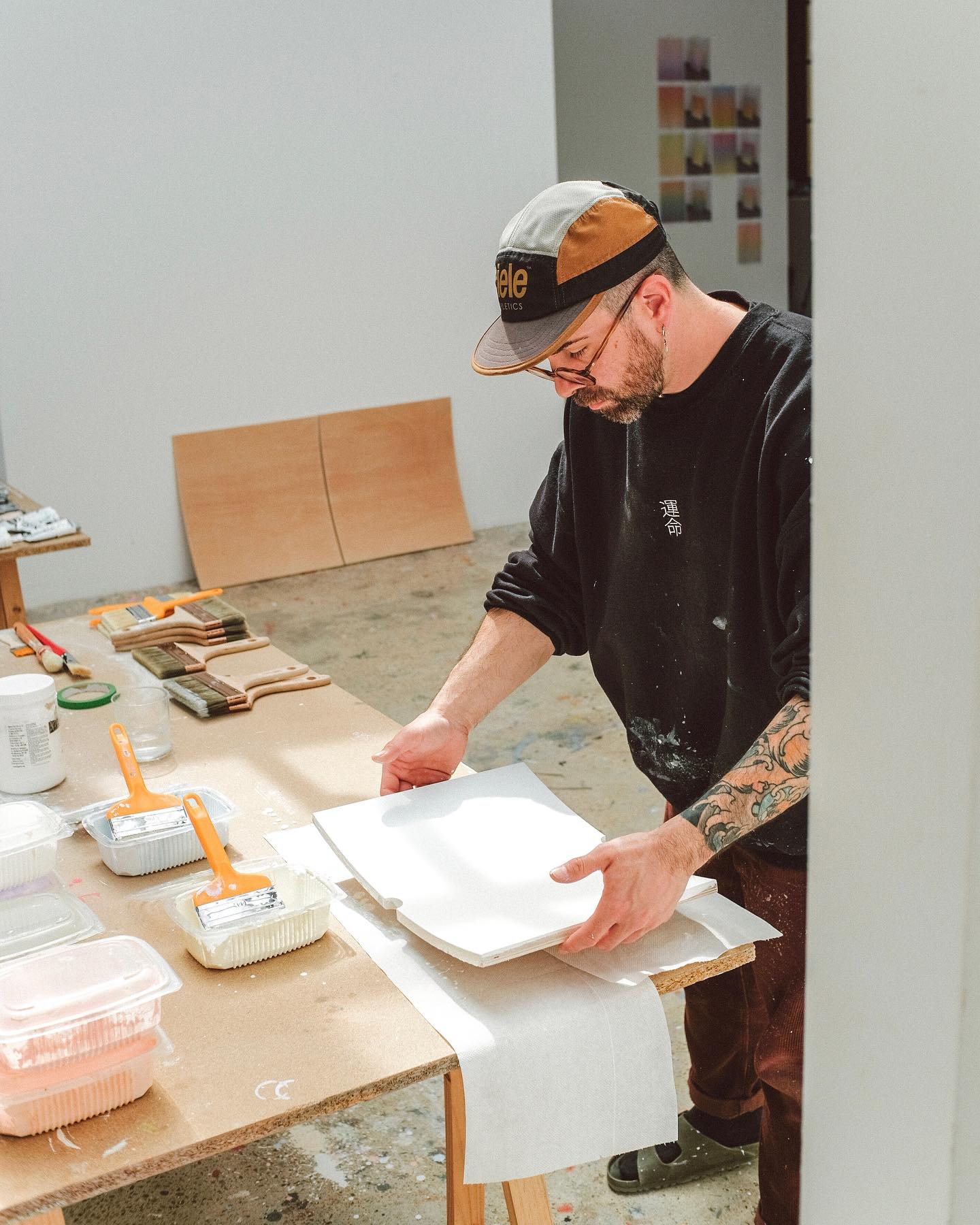
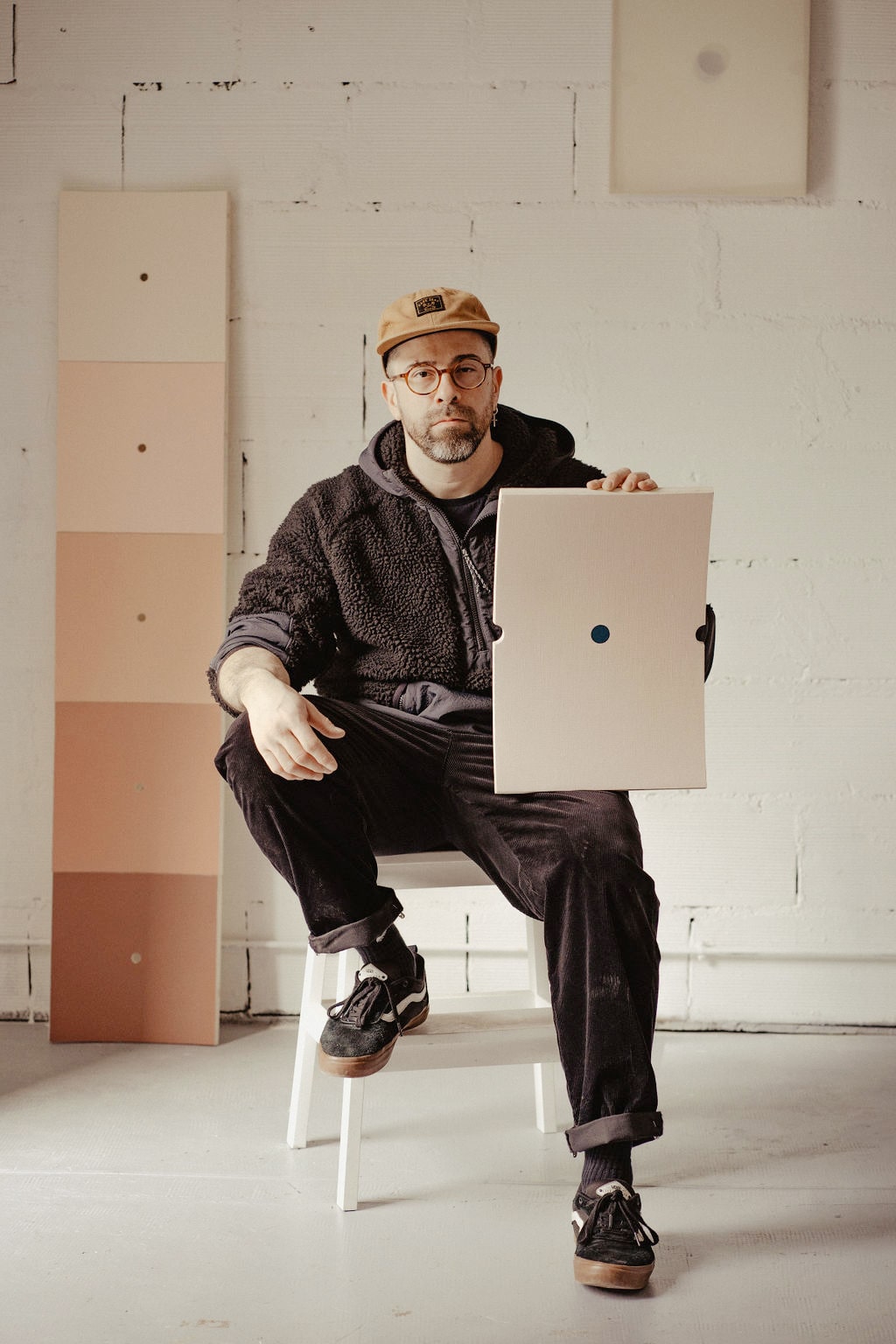
Last Updated on November 9, 2024


